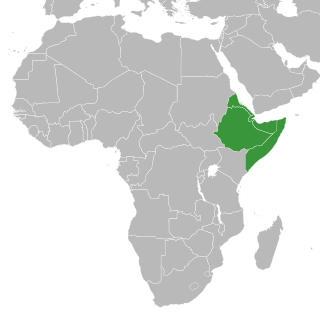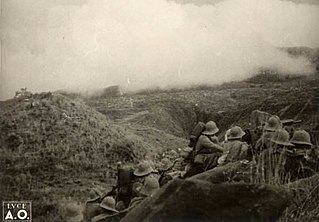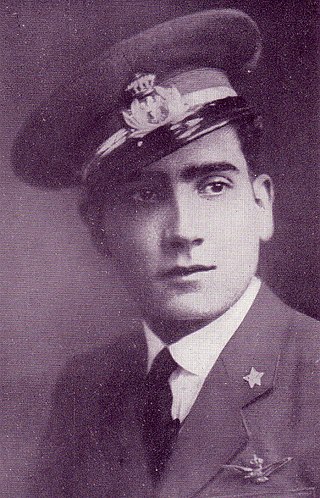
The Abyssinia Crisis, also known in Italy as the Walwal incident, was an international crisis in 1935 that originated in a dispute over the town of Walwal, which then turned into a conflict between the Fascist-ruled Kingdom of Italy and the Ethiopian Empire. The League of Nations ruled against Italy and voted for economic sanctions, but they were never fully applied. Italy ignored the sanctions, quit the League, made special deals with the United Kingdom and France and ultimately annexed and occupied Abyssinia after it had won the Second Italo-Ethiopian War. The crisis is generally regarded as having discredited the League.

The Second Italo-Ethiopian War, also referred to as the Second Italo-Abyssinian War, was a war of aggression waged by Italy against Ethiopia, which lasted from October 1935 to May 1936. In Ethiopia it is often referred to simply as the Italian Invasion, and in Italy as the Ethiopian War. It is seen as an example of the expansionist policy that characterized the Axis powers and the ineffectiveness of the League of Nations before the outbreak of the Second World War.

The Stresa Front was an agreement made in Stresa, a town on the banks of Lake Maggiore in Italy, between French prime minister Pierre-Étienne Flandin, British prime minister Ramsay MacDonald, and Italian prime minister Benito Mussolini on 14 April 1935. Practically, the Stresa Front was an alliance between France, Italy, and Great Britain, aimed against Nazi Germany. Patrick Buchanan's Churchill, Hitler and the Unnecessary War considered the Stresa Front the last chance to stop Hitler before the Second World War.
Abyssinian campaign can mean:
The Hoare–Laval Pact was an initially secret pact of December 1935 between French Foreign Minister Pierre Laval and British Foreign Secretary Sir Samuel Hoare for ending the Second Italo-Ethiopian War. Italy wanted to incorporate the independent nation of Abyssinia (Ethiopia) into its Italian Empire and also avenge the 1896 Battle of Adwa, a humiliating defeat. The pact proposed to partition Abyssinia and thus partially achieve Italian dictator Benito Mussolini's goal of making Abyssinia an Italian colony.

Emilio De Bono was an Italian general, fascist activist, marshal, war criminal, and member of the Fascist Grand Council. De Bono fought in the Italo-Turkish War, the First World War and the Second Italo-Abyssinian War. He was one of the key figures behind Italy's anti-partisan policies in Libya, such as the use of poison gas and concentration camps, which resulted in the deaths of tens of thousands of civilians and have been described as genocidal.

Conflicts in the Horn of Africa have been occurring since the 17th century BCE. The Horn of Africa includes the nations of Djibouti, Eritrea, Ethiopia, and Somalia.
Invasion of Ethiopia and Conquest of Ethiopia may refer to:

Italo Gariboldi was an Italian senior officer in the Royal Army before and during World War II. He was awarded the Knight's Cross of the Iron Cross by German dictator Adolf Hitler for his leadership of Italian forces in the Battle of Stalingrad.

The Army of the Ethiopian Empire was the principal land warfare force of the Ethiopian Empire and had naval and air force branches in the 20th century. The organization existed in multiple forms throughout the history of the Ethiopian Empire from its foundation in 1270 by Emperor Yekuno Amlak, to the overthrow of the monarchy and Emperor Haile Selassie in 1974 by members of the Ethiopian army. Due to the country's position along multiple trade routes and its maintenance of independence against multiple Islamic and colonialist invasions lead to multiple conflicts against numerous major countries including the Ottomans, Egyptians, British, and Italians.

The Battle of Amba Aradam was fought on the northern front of what was known as the Second Italo-Abyssinian War. This battle consisted of attacks and counter-attacks by Italian forces under Marshal of Italy Pietro Badoglio and Ethiopian forces under Ras Mulugeta Yeggazu. This battle was primarily fought in the area around Amba Aradam which included most of Enderta Province.
The Battle of the Ogaden was fought in 1936 in the southern front of the Second Italo-Abyssinian War. The battle consisted of attacks by the Italian forces of General Rodolfo Graziani, the commander-in-chief of the forces on the "southern front", against Ethiopian defensive positions commanded by Ras Nasibu Emmanual. The strong defensive positions were designed by Wehib Pasha and known as the "Hindenburg Wall". The battle was primarily fought to the south of Harar and Jijiga.

The Italo-Ethiopian Treaty of 1928, also known as the Italo–Ethiopian Treaty of Friendship and Arbitration, was a treaty signed between the Kingdom of Italy and the Ethiopian Empire on 2 August 1928. Nigiste Negest Zewditu I ruled Ethiopia at the time of this treaty, but it was the 36-year-old Ras Tafari Makonnen who represented the government of Ethiopia. Tafari, who was still in his minority, was heir apparent and Regent Plenipotentiary.
De Bono's invasion of Ethiopia took place during the opening stages of the Second Italo-Ethiopian War. Italian General Emilio De Bono invaded northern Ethiopia from staging areas in the Italian colony of Eritrea on what was known as the "northern front".

The Christmas Offensive took place during the Second Italo-Ethiopian War. The Ethiopian offensive was more of a counteroffensive to an ever-slowing Italian offensive which started the war.
Ethiopian War may refer to:

Tito Minniti was an Italian pilot who was killed during the Second Italo-Abyssinian War in 1935 near Degehabur. It is unknown whether he died in combat or after being captured by Ethiopian forces. His death and alleged torture became an atrocity story proffered by the Italian government to justify their use of mustard gas against Ethiopian civilians. Minniti was posthumously decorated with the Italian Gold Medal of Valour.

The Royal Corps of Colonial Troops was a corps of the Royal Italian Army, in which all the Italian colonial troops were grouped until the end of World War II in North Africa campaign.
The International African Friends of Abyssinia (IAFA), also known as the International African Friends of Ethiopia, was an organisation established in 1935 in London, England, to protest against Italian aggression against Abyssinia. Its membership was composed of many important Pan-African figures, several of whom later formed the International African Service Bureau.
The following articles deal with Ethiopia in World War II:
This page is based on this
Wikipedia article Text is available under the
CC BY-SA 4.0 license; additional terms may apply.
Images, videos and audio are available under their respective licenses.











